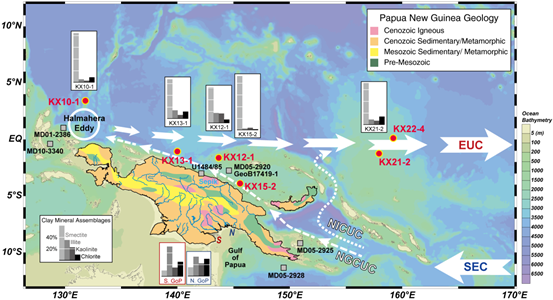Haowen Danga, Jiawang Wua, Zhifang Xiongb, Peijun Qiaoa, Tiegang Lib, Zhimin Jiana
a State Key Laboratory of Marine Geology, Tongji University, Siping Road 1239, 200092, Shanghai, China
b First Institute of Oceanography, Ministry of Natural Resources, Xianxialing Road 6, 266061, Qingdao, China
Abstract
Iron (Fe) supplied to the equatorial Pacific are thought to play a critical role in marine biogeochemical cycle and the related airesea CO2 flux. Previous studies have shown that Papua New Guinea (PNG) is a major Fe contributor for the western equatorial Pacific. However, key issues of this Fe supply including the exact sources, transport processes and distribution range remain unclear, especially its long-term variability associated with hydroclimatic and paleoceanographic changes. Using a set of cores collected offshore the northern PNG and from the Ontong-Java Plateau (OJP), shown to situate along the pathway of Fe delivery by undercurrents, here we compile high-resolution records to explore how the Fe-associated sediment supplies varied and distributed on orbital time-scale during the past 400 ka. The chronologic frameworks of these cores are established by using 14C datings and stratigraphic correlations of foraminiferal d18O records and carbonate contents. The sedimentary Fe and clay-mineral smectite in the offshore-PNG sites show a prominent precession cycle, in phase with the March insolation change at 5S. Such precessional predominance suggests the control of local precipitation and river runoff on the offshore deposition of the Fe-associated sediment. For the OJP sites the proxies derived from terrigenous detrital component give a spectral pattern, however, prevailed by ~100-ka cycle with secondary precessional highs. The significant 100-ka cycle can best be attributed to glacialeinterglacial changes in oceanic transports, likely caused by sea-level regulated variability in the strength and/or route of the coastal undercurrents off PNG. This variability may have influenced the long-distance transport of Fe-rich particulates from the PNG to the OJP, and further eastwards via the Equatorial Undercurrent.
Full article: https://www.sciencedirect.com/science/article/pii/S0277379120303231



